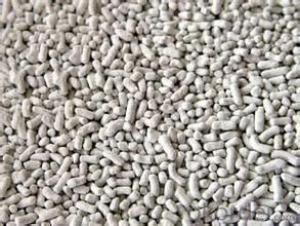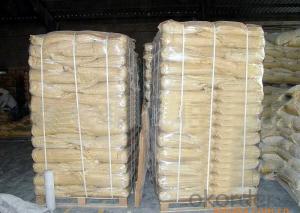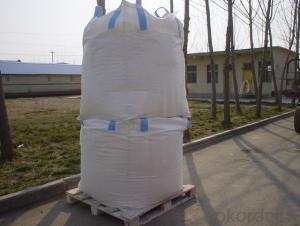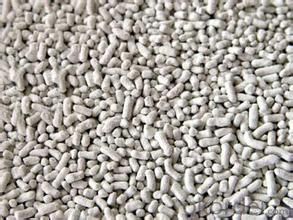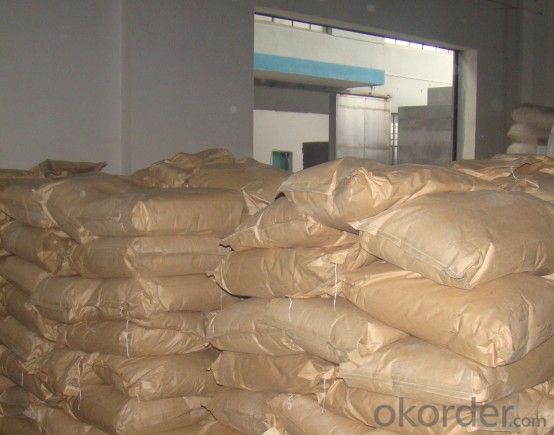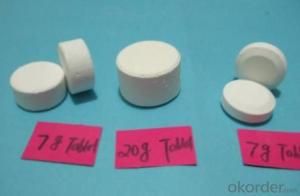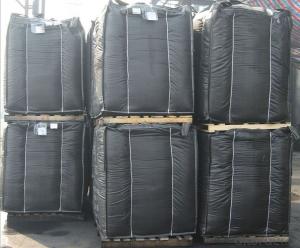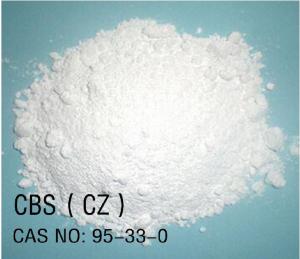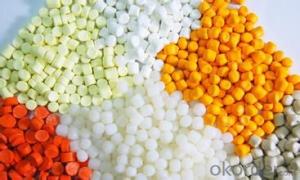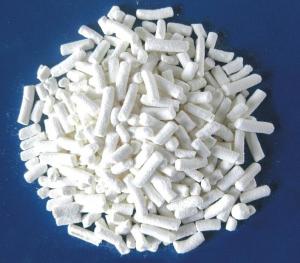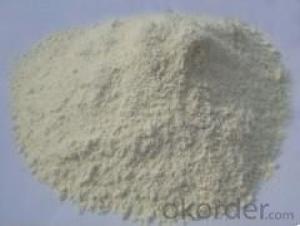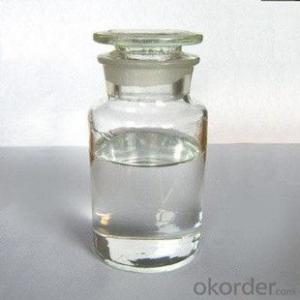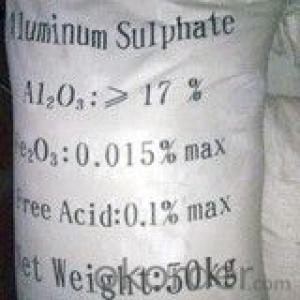RUBBER VULCANIZING ACCELERATOR CHEMICALS CZ
- Loading Port:
- Tianjin
- Payment Terms:
- TT OR LC
- Min Order Qty:
- 25 m.t.
- Supply Capability:
- 12000 m.t./month
OKorder Service Pledge
OKorder Financial Service
You Might Also Like
RUBBER VULCANIZING ACCELERATOR CBS(CZ)
Chemical Name: N-Cyclohexyl-2-benzothiazole sulfenamide
Molecular Formula: C13H16N2S2
Molecular Weight: 264.4
CAS NO. : 95-33-0
Executive standard:HG/T 2096-2006
Specification:
| Index | ||
High-class products | First-class products | Acceptable end-product | |
Appearance |
| ||
Initial M.P,oC ≥ | 99.0 | 98.0 | 97.0 |
Loss on drying,% ≤ | 0.20 | 0.30 | 0.50 |
Ash, % ≤ | 0.20 | 0.30 | 0.40 |
Residue,% ≤ | 0.00 | 0.05 | 0.10 |
In soluble in Methanol,% ≤ | 0.50 | 0.50 | 0.80 |
Purity,% ≥ | 97.0 | 96.0 | |
Free amine,% ≤ | 0.50 | ||
Properties: Gray, light yellow powder or granules with a little odor, no poison. The density is 1.31-1.34. And melting point 90-108 oC .Soluble benzene, methylene chloride, carbon tetrachloride, ethyl acetate, acetone, ethanol-soluble and petrol do not dissolve in water.
Application: to promote common aftereffect on sexual one. Furnace applicable to the use of black plastic material, both anti-burning performance and excellent short curing time two major advantages. Enable for natural rubber, recycled rubber, vinyl synthetic rubber, especially for the SBR. May be used alone, but also with promoting agent D, DT, TT, TS and others use. Because of a bitter, it can not be used for food-related products. Photochromic minor, do not emit cream vulcanizate excellent anti-aging properties. Used tires, shoes, hose and belt, cable, general industrial products.
Packaging: 25kg plastic woven bag, paper with plastic film bag, Kraft paper bag or jumbo bag.
Storage: The product should be stored in the dry and cooling place with good ventilation, avoiding exposure of the packaged product to direct sunlight. The validity is 1 year.
Note: The product could be ultra fine powder based on customer accurate requirement.
- Q: Chemistry is often said that the catalyst can change the material reaction rate, rate and speed What is the difference
- The rate is only size, no direction, speed both size and direction
- Q: how could scientists know the exact catalyst for every reactions??? THANX sooo much
- Believe me, nema, there's no way that we chemists know the best catalyst for every reaction. That would be simply impossible. However, from the type of reaction, the reactants, products, reaction conditions, solvents, etc. and from one's experience and the literature (papers and patents) one can get a good idea for most reactions of the type of catalyst that has worked for similar systems. One then starts off with a catalyst from the literature and modifies or changes it if improvement is needed based on chemical principles that one learns. There are also some theoretical calculations that can be made. Sometimes they work and sometimes they don't :) If it is an industrially important process like the Haber process for making ammonia from nitrogen gas and hydrogen gas, there may be thousands of catalysts which have been tried and evaluated. New minor improvements are being made every day. When a company does find a very good catalyst for an important reaction, often they keep it a trade secret. The good catalyst can make a huge difference in how commercially successful a particular process is. That's a large part of what chemical engineers do. You may never know if you have the best catalyst. The most you can hope for is one that is good enough. So it's a few parts personal knowledge, a few parts literature, a couple of parts theory, a lot of experimentation and often, more than not, a little luck. :)
- Q: Seems intuitive that it wouldn't, but I dunno the qualitative difference between activation energy & Gibbs free energy. I'M TOO LAZY TO GOOGLE I GOTS STUFF TO DO
- A catalyst can change the activation energy not the Gibbs energy. The Gibbs energy is the energy difference between the initial state and final state. A catalyst cannot change that. Imagine you are driving from school to home. How you drive do not change the height difference between the school and your home. However, a catalyst can change your path which can change the routine you drive from school to home. So if there is a hill in between your school and you home, you have the choice to drive through it or drive around. Here is a picture: upload.wikimedia.org/wikipedia/co... A catalyst can change the height of the barrier, but cannot alter the initial or final state.
- Q: What is the quality of the catalyst in the chemical reaction, for example, 34.3 g before the hydrogen peroxide reaction, 32.7 g after the reaction, and how much is the catalyst mass?
- You can not calculate this question, the quality of the catalyst before and after the same reaction, how much reaction before the reaction on how much
- Q: Will the catalyst change in the chemical reaction?
- In fact, there are two kinds of catalyst mechanism, one is not a chemical reaction, the reaction did not occur throughout the chemical reaction, the catalyst did not change; one is involved in the reaction process, but the final production of the catalyst, which The class reaction generally occurs in a stepwise chemical reaction.
- Q: Several experiments were carried out using catalysts
- Hydrogen peroxide in the manganese dioxide as a catalyst for decomposition reaction: 2H2O2 == MnO2 == 2H2O + O2 ↑ (laboratory oxygen principle)
- Q: Does increasing the amount of catalyst added to, say, a solution of Hydrogen Peroxide, make the rate of reaction go faster. Is the rate of reaction directly proportional to the amount of catalyst added to the solution? Or does the experiment go at the same rate regardless of how much catalyst there is? Thanks would really appreciate some answers. - Sarah
- Adding a catalyst would increase the rate of reaction. This could decrease the activation energy, the amount of kinetic energy needed for the reaction to occur. Hope that helps
- Q: Word editor when playing chemical equation = with the above conditions or how to adjust the size of the catalyst, how to make it centered,
- Open the word - insert - object - WPS3.0 formula - and then select the "label arrow template", you can add a catalyst.
- Q: In biology, the enzyme seems to be a tool for opening a reaction, such as the decomposition of cellulose, such as linked RNA and protein, no enzyme can not. But in chemistry, the catalyst is only a regulatory role, change the reaction rate only. The teacher said that the enzyme is the catalyst. Is there any other effect of the enzyme? (Ignorant high three dogs, you do not spray the big god)
- I do not know the main high school teachers have done with fresh chicken liver grinding solution and ferric chloride solution compared to the decomposition of H2O2 catalytic efficiency of the experiment, the result is ferric chloride plus H2O2 slowly take the bubble, add fresh chicken cups Quickly take bubbles and liquid spill. Indicating that the enzyme is a catalyst, and the catalytic efficiency is far higher than the inorganic catalyst.
- Q: how do catalysts help in green chemistry?
- Catalysts reduce the energy barrier for reactions, meaning they require less energy to make the forward reaction go. This means less heat, light, or other energy sources are required to perform the same reaction without a catalyst. Also, by definition, a catalyst is not consumed in a reaction and can therefore be recycled many many times before replacement is necessary.
Send your message to us
RUBBER VULCANIZING ACCELERATOR CHEMICALS CZ
- Loading Port:
- Tianjin
- Payment Terms:
- TT OR LC
- Min Order Qty:
- 25 m.t.
- Supply Capability:
- 12000 m.t./month
OKorder Service Pledge
OKorder Financial Service
Similar products
Hot products
Hot Searches
Related keywords
